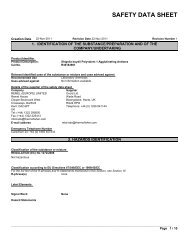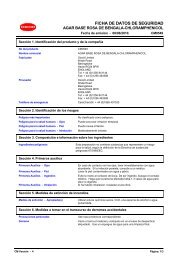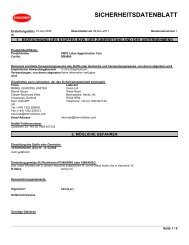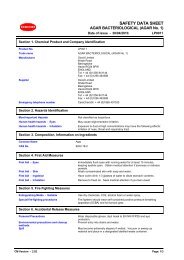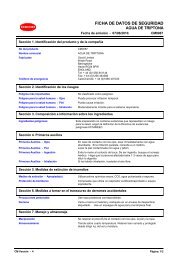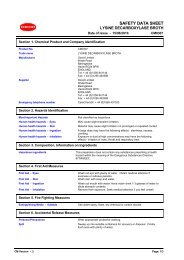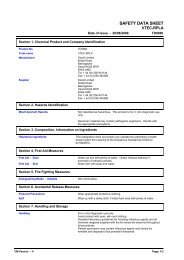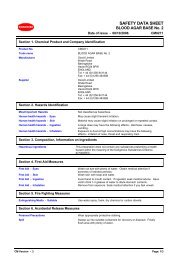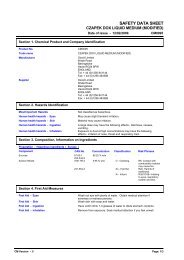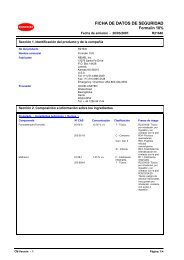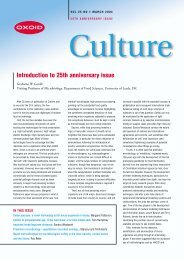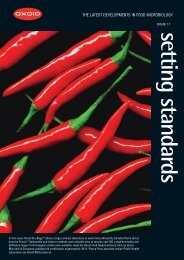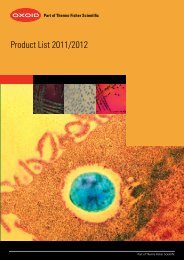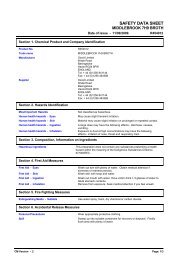IMAGEN™ Adenovirus - Oxoid
IMAGEN™ Adenovirus - Oxoid
IMAGEN™ Adenovirus - Oxoid
Create successful ePaper yourself
Turn your PDF publications into a flip-book with our unique Google optimized e-Paper software.
10.3 WASHING THE SLIDE<br />
Wash off excess reagent with Phosphate Buffered Saline (PBS) then gently wash the slide in an agitating<br />
bath containing PBS for 5 minutes. Drain off PBS and allow the slide to air dry at room temperature (15-30<br />
°C).<br />
10.4 ADDITION OF MOUNTING FLUID<br />
Add one drop of IMAGEN <strong>Adenovirus</strong> mounting fluid to the centre of each well and place a coverslip over<br />
the mounting fluid and specimen ensuring that no air bubbles are trapped.<br />
10.5 READING THE SLIDE<br />
Examine the entire well area containing the stained specimen using an epifluorescence microscope.<br />
Fluorescence, as described in Section 11, should be visible at x200-x500 magnification. (For best results<br />
slides should be examined immediately after staining, but may be stored at 2-8 °C, in the dark, for up to 24<br />
hours).<br />
11 INTERPRETATION OF TEST RESULTS<br />
11.1 CONTROLS<br />
11.1.1 Positive Control Slide<br />
When stained and viewed as described in Section 10, the positive control slide should show cells with<br />
intracellular nuclear and/or cytoplasmic apple-green fluorescence contrasting against a background of red<br />
counterstained material. These cells are slightly larger than respiratory or conjunctival epithelial cells but<br />
show similar intracellular, nuclear and/or cytoplasmic fluorescence when infected with adenovirus. Positive<br />
control slides should be used to check that the staining procedure has been satisfactorily performed.<br />
11.1.2 Negative Control<br />
If a negative control is required, uninfected intact cells of the type used for the culture and isolation of<br />
adenovirus are recommended. The cells should be prepared and fixed as described in Section 9.2 and<br />
stained as described in Section 10.<br />
11.2 CLINICAL SPECIMENS<br />
11.2.1 Appearance of <strong>Adenovirus</strong> Infected Cells<br />
Intracellular, nuclear and/or cytoplasmic granular apple-green fluorescence is seen in respiratory or<br />
conjunctival epithelial cells infected with adenovirus.<br />
Uninfected cells stain red with the evans blue counterstain.<br />
11.2.2 Interpretation of Results<br />
A positive diagnosis is made when one or more cells in the fixed, stained specimen show the typical<br />
fluorescence pattern described in Section 11.2.1.<br />
A negative diagnosis is made when fixed, stained specimens do not exhibit fluorescence with the reagent.<br />
For directly stained nasopharyngeal aspirate or ophthalmic specimens, at least 20 uninfected respiratory or<br />
conjunctival epithelial cells must be observed before a negative result is reported. See Section 11.2.3 if<br />
insufficient cells are present.<br />
7/37 K6100EFG



